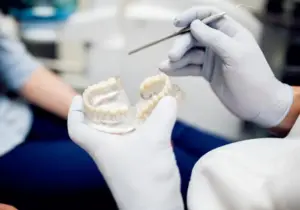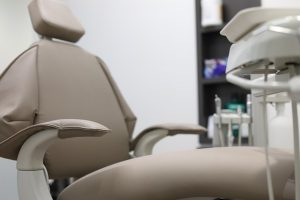Dental bone grafting is exactly what it sounds like—it’s a procedure where parts of your bone are grafted to your jaw to aid in bone regeneration and increase both the volume and density around the jawbone.
At the same time, bone grafting also sounds kind of scary. Even the thought of scraping off bone material to graft onto your jawbone sounds painful. However, that preconception couldn’t be further from the truth. Bone grafting is a relatively quick, painless procedure that really helps out patients who need it. Here’s the gist on bone grafting performed during oral surgeries.
What Sorts of Dental Procedures Use Bone Grafting?
Bone grafting from an oral surgeon is a vital step in the following procedures:
- Dental implants – supplanting bone material in the mouth is sometimes necessary prior to an implant to restore enough of the jawbone for the surgery to be successful.
- Tooth extractions – following a tooth extraction, bone graft material is placed where the tooth once was. This preserves jawbone health for possible future implants or work.
- Sinus lifts – this process involves lifting the sinuses in an attempt to graft more bone material in the upper jaw for tooth implants.
- Bone loss from gum disease – gum disease causes major bone loss around the teeth, and a graft helps repair and stabilize the jaw.
- Maxillofacial surgery – dental bone grafts repair and rebuild the jaw following trauma or accidents.
- Denture prep – a bone graft on the jaw helps ensure better fits and stability for dentures.
While it’s used in a wide variety of situations, the reason for grafting bone material in a patient’s mouth remains the same: it enhances the existing jawbone and helps keep it in stable condition for both a patient’s long-term oral health and for possible future procedures.
How Exactly Do Oral Bone Grafts Help Regenerate Existing Bone?
Bone graft materials are sort of like the framework that holds everything together. They’re more of a physical structure that helps hold space for all of those good bone-forming cells that naturally occur in our bodies to migrate into.
After the graft is placed, a blood clot forms inside the graft material. Blood clots contain a plethora of growth factors and molecules that work by attracting neutrophils and macrophages (healing cells) to the site of the graft. Over the weeks following a bone graft performed by an oral surgeon, bone-forming cells continue to migrate to the site. These cells set the groundwork for mature bone tissue to grow, which finishes roughly a year after a graft.
A more recent innovation in dental bone grafts is using growth factors like platelet-rich-fibrin (PRF) to help enhance and speed up the bone grafting process. PRF is packed full of growth factors that promote healing, rejuvenation, and—you guessed it—bone growth. Used in tandem with a procedure that takes bone from other areas to put into the jawbone, it accelerates growth at rapid speed.
Bone Graft Material is Taken from Different Sources
There are a few ways to obtain bone grafting material. The most common methods are as follows:
- Autografts – perhaps the easiest of them all, autogenous grafts use the patient’s own material to graft bone around the jaw and mouth. The biggest benefit of this method is that it’s naturally biocompatible, and there’s a near-zero chance of the graft rejecting.
- Allografts – bone material comes from deceased human donors. The downside to using graft material from deceased humans or animals is that the cells are not alive and may not be quite as speedy as an autograft at regenerating bone material.
- Xenografts – the bone material here is taken from animal sources, typically cows or pigs. The material undergoes tons of processing and testing to ensure sterility and quality. There’s a large supply of this material available, and it generally doesn’t reject. If you’ve ever wanted to claim that you’re part animal, now’s your chance.
In almost all cases, autografts will be the gold standard that most dental surgeons want to use when placing bone material onto a patient’s jawbone. The only downside is that it requires a second surgical site to harvest the bone material, but it’s quick and taken from inconspicuous areas like the chin, hips, or tibia.
Bone Grafting Around the Jaw is Happens All the Time
Despite the name sounding intimidating and like it’s used in only severe situations, bone grafting is an incredibly common dental procedure. In fact, there’s a good chance that someone you know has had a bone graft. Millions of bone grafts are performed every year. It’s only second to blood transfusions when it comes to popular tissue transplantation procedures.
Are Bone Grafts Permanent?
If you have lost any teeth, your jaw has atrophied somewhat. This is perfectly natural, and happens to everyone after tooth loss. If a tooth is not there, then the jaw has no need to extend upward to where the natural socket had been. It retreats to what we refer to as basal bone, which is a narrower hoop.
Today, we use bone grafts to prevent that decline in jaw size and strength. This placeholder material prevents the tissues surrounding it to collapse. Then your own body recognizes the grafted material, and replaces the graft with your own natural bone-forming cells.
Essentially, it is a temporary measure. The graft shows your body that there should continue to be natural bone built there, and your body fills it in with your own native calcium to rebuild your jaw and prevent atrophy.
Three main approaches are the most common in bone grafting:
- The “Sinus Lift” or Subantral Graft.
- The “Block Bone Graft” on Autogenous Ramus / Chin Graft.
- The “Socket Graft” or Alveolar Ridge Preservation Graft.
Give us a call at (937) 382-8020 and we can set up a time to meet in person. We can also talk about any of your questions in the meantime.










